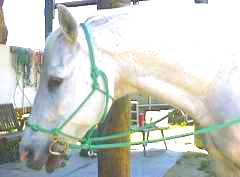|
When working with horses which are young and inexperienced,
gentling an adopted wild horse or working with a horse
who displays behavior problems, it is of utmost importance to
use the right equipment. Even with well broke horses,
using the right equipment makes handling horses safer, more
predictable and easier on both horse and handler. This information
sheet is devoted to discussing rope halters.
A halter can have a great deal more purpose than merely attaching
a horse to a rope. It is a primary means of communicating with the
horse when handling him from the ground. Yet, I see time and again
people using web or leather halters, padding them so that they will
be comfy, then running for a stud chain when they want the horse to
do anything. There IS a better way!
Let's consider the purpose of any device which we use on a horse:
It needs to convey a message.
That message needs to be clear and not include a bunch of "background noise".
It needs to be safe for both horse and handler
It needs to be both durable and reliable
We have used just about every halter there is and there is nothing
which we have found that comes anywhere near the effectiveness and
usefulness of a hand tied marine grade kernmantle braid rope halter and lead rope.
 The halter is humane in that it won't cut the horse, yet the horse can
clearly feel it and the "message" the handler is sending through it.
It doesn't get stiff, won't break, and can be thrown in the washing machine
when dirty. The same material in a lead rope or "horse handling" rope
won't kink, doesn't easily "burn" the hands (although any rope can under
the right set of circumstances), has a great weight and feel to it, and
is similarly "maintenance free." We have used these items for years
on everything up to and including draft horses and we've yet to wear one out.
The halter is humane in that it won't cut the horse, yet the horse can
clearly feel it and the "message" the handler is sending through it.
It doesn't get stiff, won't break, and can be thrown in the washing machine
when dirty. The same material in a lead rope or "horse handling" rope
won't kink, doesn't easily "burn" the hands (although any rope can under
the right set of circumstances), has a great weight and feel to it, and
is similarly "maintenance free." We have used these items for years
on everything up to and including draft horses and we've yet to wear one out.
 The rope halter itself is light and pliable so that it conforms to
the horse in such a way that it can make very effective contact without
hurting the animal. It has single strands along the cheekbones and double
strands across the poll and nose so if the horse pulls or "makes contact",
he will feel the greater contact without getting cut. The surface of the rope
is smooth and soft enough so that when properly put on, the horse should not
ever rub sores into himself (although I have seen a couple of very committed "halter
pullers" rub some very minor sores on the sides of their lips before they gave up
fighting the halter.)
The rope halter itself is light and pliable so that it conforms to
the horse in such a way that it can make very effective contact without
hurting the animal. It has single strands along the cheekbones and double
strands across the poll and nose so if the horse pulls or "makes contact",
he will feel the greater contact without getting cut. The surface of the rope
is smooth and soft enough so that when properly put on, the horse should not
ever rub sores into himself (although I have seen a couple of very committed "halter
pullers" rub some very minor sores on the sides of their lips before they gave up
fighting the halter.)
| 
 The halter is humane in that it won't cut the horse, yet the horse can
clearly feel it and the "message" the handler is sending through it.
It doesn't get stiff, won't break, and can be thrown in the washing machine
when dirty. The same material in a lead rope or "horse handling" rope
won't kink, doesn't easily "burn" the hands (although any rope can under
the right set of circumstances), has a great weight and feel to it, and
is similarly "maintenance free." We have used these items for years
on everything up to and including draft horses and we've yet to wear one out.
The halter is humane in that it won't cut the horse, yet the horse can
clearly feel it and the "message" the handler is sending through it.
It doesn't get stiff, won't break, and can be thrown in the washing machine
when dirty. The same material in a lead rope or "horse handling" rope
won't kink, doesn't easily "burn" the hands (although any rope can under
the right set of circumstances), has a great weight and feel to it, and
is similarly "maintenance free." We have used these items for years
on everything up to and including draft horses and we've yet to wear one out. The rope halter itself is light and pliable so that it conforms to
the horse in such a way that it can make very effective contact without
hurting the animal. It has single strands along the cheekbones and double
strands across the poll and nose so if the horse pulls or "makes contact",
he will feel the greater contact without getting cut. The surface of the rope
is smooth and soft enough so that when properly put on, the horse should not
ever rub sores into himself (although I have seen a couple of very committed "halter
pullers" rub some very minor sores on the sides of their lips before they gave up
fighting the halter.)
The rope halter itself is light and pliable so that it conforms to
the horse in such a way that it can make very effective contact without
hurting the animal. It has single strands along the cheekbones and double
strands across the poll and nose so if the horse pulls or "makes contact",
he will feel the greater contact without getting cut. The surface of the rope
is smooth and soft enough so that when properly put on, the horse should not
ever rub sores into himself (although I have seen a couple of very committed "halter
pullers" rub some very minor sores on the sides of their lips before they gave up
fighting the halter.)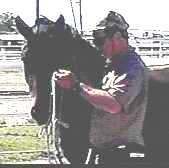
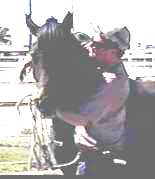
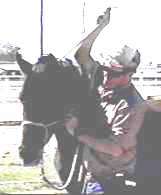
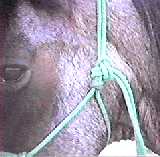 There is a little secret to tying the poll strap so that it can be
easily loosened if the horse pulls. Draw the poll strap down through
the halter eye. Bring it down, to the rear of and around the eye, then
across the front of the eye and tuck it through itself. This may sound
complicated, but it's really pretty easy. The idea here is NEVER to tie
the poll strap up around itself because the knot could cinch tight under
pressure and be very difficult to remove. By tying around the eye of the halter, you
can always slide the eye back up to loosen things if the horse pulls
and the knot gets tight.
There is a little secret to tying the poll strap so that it can be
easily loosened if the horse pulls. Draw the poll strap down through
the halter eye. Bring it down, to the rear of and around the eye, then
across the front of the eye and tuck it through itself. This may sound
complicated, but it's really pretty easy. The idea here is NEVER to tie
the poll strap up around itself because the knot could cinch tight under
pressure and be very difficult to remove. By tying around the eye of the halter, you
can always slide the eye back up to loosen things if the horse pulls
and the knot gets tight. Pat Fredrickson, who makes and sells high quality hand made rope halters has so
kindly provided this illustration which better shows you how to tie the
halter. This knot is known as the "latch knot." You can find Pat's
halters and leads at
Pat Fredrickson, who makes and sells high quality hand made rope halters has so
kindly provided this illustration which better shows you how to tie the
halter. This knot is known as the "latch knot." You can find Pat's
halters and leads at
